-
Posts
7,153 -
Joined
-
Last visited
-
Days Won
5
Content Type
Profiles
Forums
Blogs
Gallery
Events
Store
Posts posted by Ulsterman
-
-
This is what I have:
" Olszwski, Kazimierz.
Polish party and government official. born August 9, 1917 in Trzes'niewo, Lwow district, from a working class family.
Studied at Lwow Higher Polychnical School. Red army officer, fought at Stalingrad (1941-43). Officer in the Polish (Berling) army in USR 1943-45.
Director for administration and trade affairs in synthetic fibers factory in Jelenia Gora 1947. Later at the Design Office of synthetic fibers in Lodz.
Director of department in the Ministry of Chemical Industry 1952-53. Promoted to Undersecretary of State in Ministry of Chemical Industry 1953-59.
Deputy Permanent Representative of Poland to CMEA in Moscow 1959-1961. Again, 1970-1971.
First Deputy Chairman of the Committee on Economic Cooperation with Foreign countries at the Council of Ministers 1962-1970.
Promoted Minister of Foreign Trade, Feb. 1971-March, 1972.
Deputy Prime Minister of Council of Ministers, March, 1972- December, 1977.
Minister of Shipping (!) Nov. 1973-April, 1974.
Minister of Foreign Trade and Maritime Economy, April -November, 1974.
Permanent Representative of Poland to CMEA October, 1975-December, 1977.
Chairman of CMEA Executive Committee, July, 1976-June, 1977
POLISH AMBASSADOR to USSR, Jan 1978-, June, 1982
Member PUWP Central Committee, December 1971-July, 1981,
Sejm (Parliament) Deputy: March 1976-March, 1980.
Member of the Main Council of the union of Fighters for Freedom and Democracy, 1974
awards: Order of Builders of Polish Peoples' Republic, Banner of Labour 1st class,Officers' Cross of Polonia Restitua, cross of valor.
0 -
O.M.G.! Owain! you lucky dog!
0 -
Ack! No regimental number on shoulder boards!

That is quite a career, from Unterofficer to Unterlt. in a few short years.
What is the arm badge on his sleeve in picture 2? Marksman or Jaeger thingy?
0 -
Heres the full back (sorry, my pencil notes in margin)
 0
0 -
I am guessing that Tamura and Shartle knew each other. On eBay there were a series of officers' portraits sold (being sold) by an antique dealer up the road that clearly come from the Shartle estate. I suspect Shartle is the man in the cap over Tamuras' right shoulder in the 1911 maneuvers photograph.
The Spanish attache' is still for sale I note.
0 -
The great Post card collector Christine (the daily post? blog) has this signed postcard from Shartle from the 1910 maneuvers with signatures. Note the Nobel Prize winner.
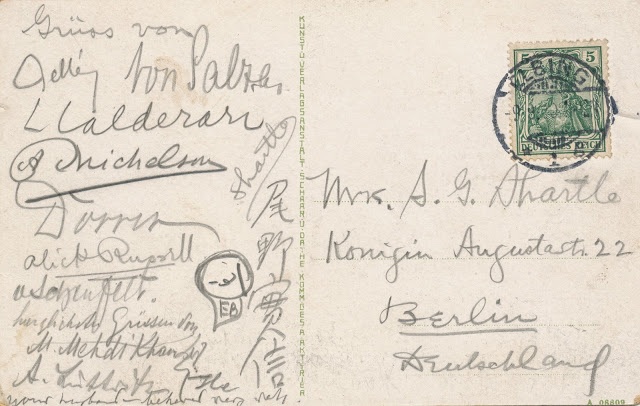 0
0 -
.......and now, the rest of the story.......
the picture itself is addressed to a Hauptmann Shartle" (smudged) which led me a merry chase through various German ranklists from 1911-1914. Eventually I figured out that Shartle was in fact, an American and not only that, but married to a woman whose family still lives 2 towns up from me.
Samuel G. Shartle was born in 1871, from an old WASP family in Pennsylvania. A member of the SAR, he graduated from Lafayette college in 1891. In 1898 he volunteered for the war with Spain and was made a Corporal in the PA. volunteer infantry. In 1899 he was mustered out and accepted a commission as a 2nd Lt. in the newly established "Negro " 38th US infantry. He served with the 38th until 1901. He received both the Spanish war and Phillipene campaign medals. In August, 1901 he transferred into the Coastal Artillery as a Lt. and by 1903 was in station at the fort in Portland, Maine where he met and married a pretty heiress named Marian Chapman, who was from Cumberland Foreside, still one of the most exclusive zip codes in the USA. Ms. Chapman is a distant cousin of the actress Helen Hunt.
In 1906 Shartle was the Honor graduate at the US artillery school and got promoted to the lofty rank of Captain in January, 1907, at age 36!
In 1909 he was apponinted the military attache in Berlin. He was presented to the Kaiser in Potsdam and attended the Kaisermanouvres, where he met Winston Churchill. He attended the Kaisermanouvres every year until 1914. He took an avid interest in the development of Germanys' air arm and his letters can be seen in the Congressional Quarterly on the subject. He was one of the first to suggest that battleships might be vulnerable to bombing by airplanes.
He and his wife very much enjoyed the glamour and exotic whirl of Germanys' social and diplomatic life. Mrs. Shartles' diary was sold on eBay last month for $1,400. In it she details balls, teas, intrigues and other events. One of the most interesting is having tea with the new Chinese Republican ambassador and attache and his "tiny, doll like" wife. That man's great grand daughter is now a billionaire and CPCP cadre....and a graduate of Cambridge (and was working in a London fish and chip shop when I met her).
Shartle left Germany in 1915 and later served on the US General Staff.
He was part of the US delegation at Versailles and wrote a book about his experiences.
He was rotated from the staff in 1922 and given command of a fort in Newport, RI.
Afterwards he made it to Colonel and retired to Cumberland, Maine. By 1930 he was fed up with the winters and had relocated to Dade County Florida, where he wrote another book on fortifications in the Great War and his magnum opus, a translation of the war diary of a German condittori who fought in central Europe some 500 years before.
Not bad for a little photo off eBay.
0 -
hmmmmmm....maybe...theres a "Diary of General Somebody " that sounds like this. Off to Abe books.
Here is Tamura at the 1911 Kaisermanouvres in Silesia, probably watching incredulous as charging German hussars "successfully" attack infantry in trenches. From Woodwards' "Armies of the World" (1978).
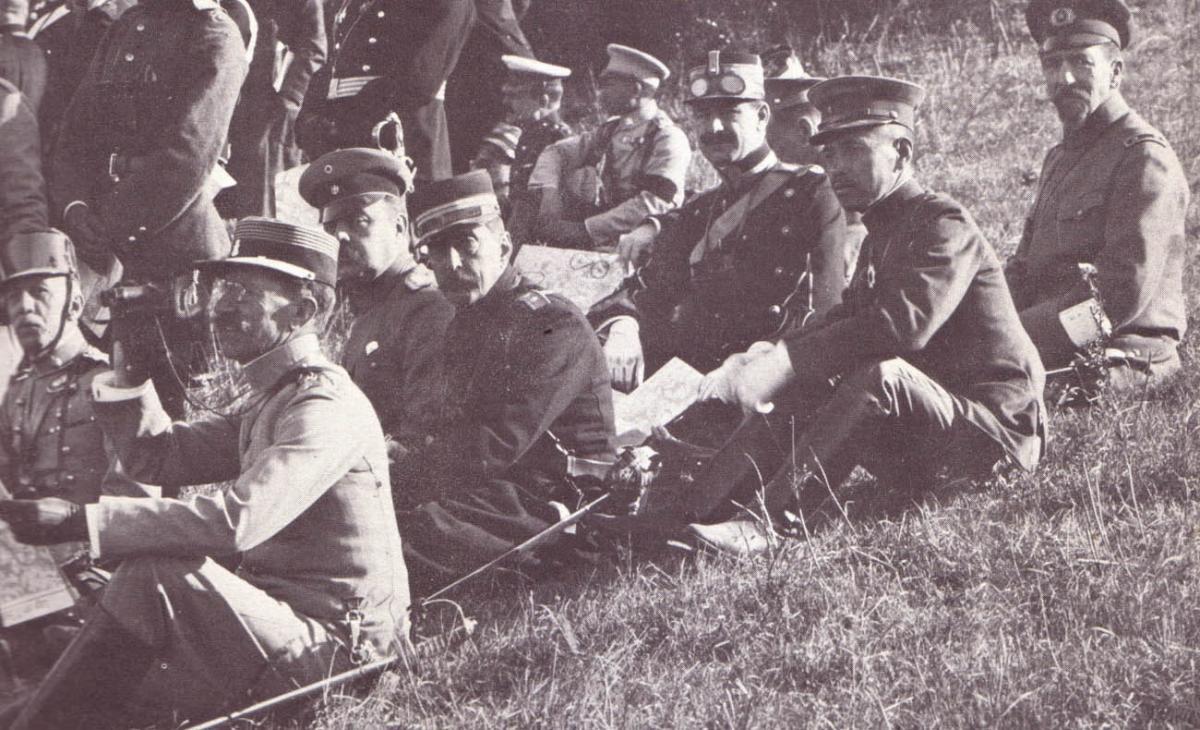 0
0 -
Outstanding! Id LOVE to see this material.
Hotta only references Satsuma briefly, but even today Japanese political factions are split along some of those old clan lines. Even at the last war conference where Hirohito was hinting strongly that attacking the US was the wrong thing, the army/navy rivalry kept the officers from discerning his intent.
I suspect Tamura served under General Nogi upon his return to Japan/Manchuria and thus his older brother helped his career. Nogi NEVER recovered fully from losing the imperial standard during the Satsuma rebellion and eventually committed seppuku after the Meiji Emperor died.
0 -
I suspect this is Tamura later in 1905.
also, the inscription...
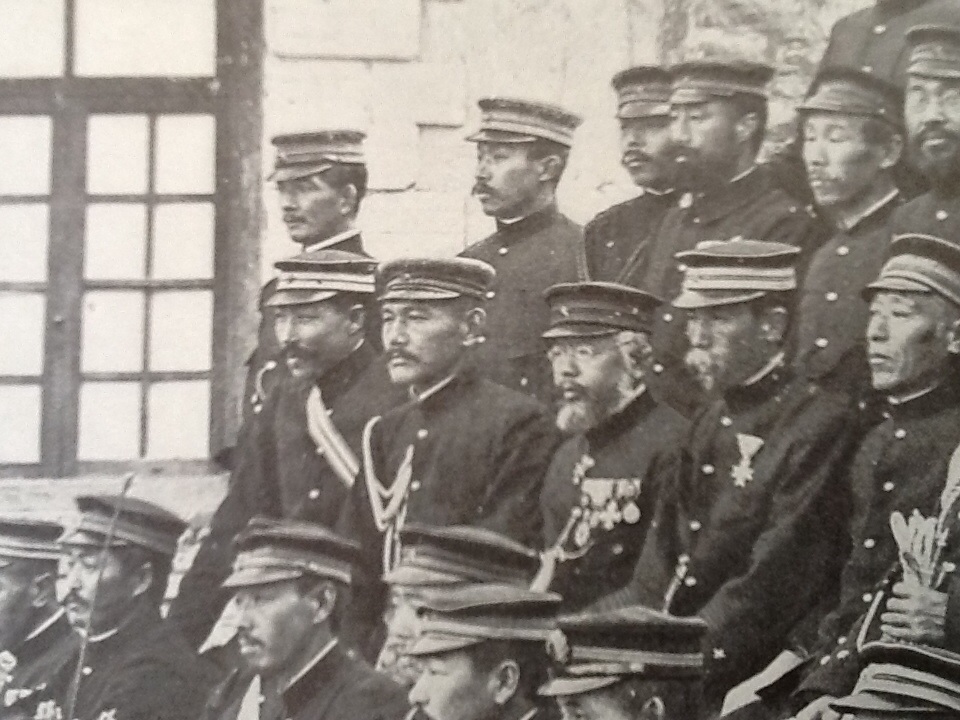
 0
0 -
Tamuras' medal bar:
Rising Sun, 3rd class at neck,
1. Golden Kite
2. Sacred Treasure, 5th class
3. Imperial Constitution promulgation (1889)
4. Sino-Japanese war medal
5. Russo-Japanese war medal
staff college badge
By his death he would have had the 1914/5 war medal as well, been due the Allied victory medal and probably donated/bought the red cross medal (it was the patriotic fashion to do so).
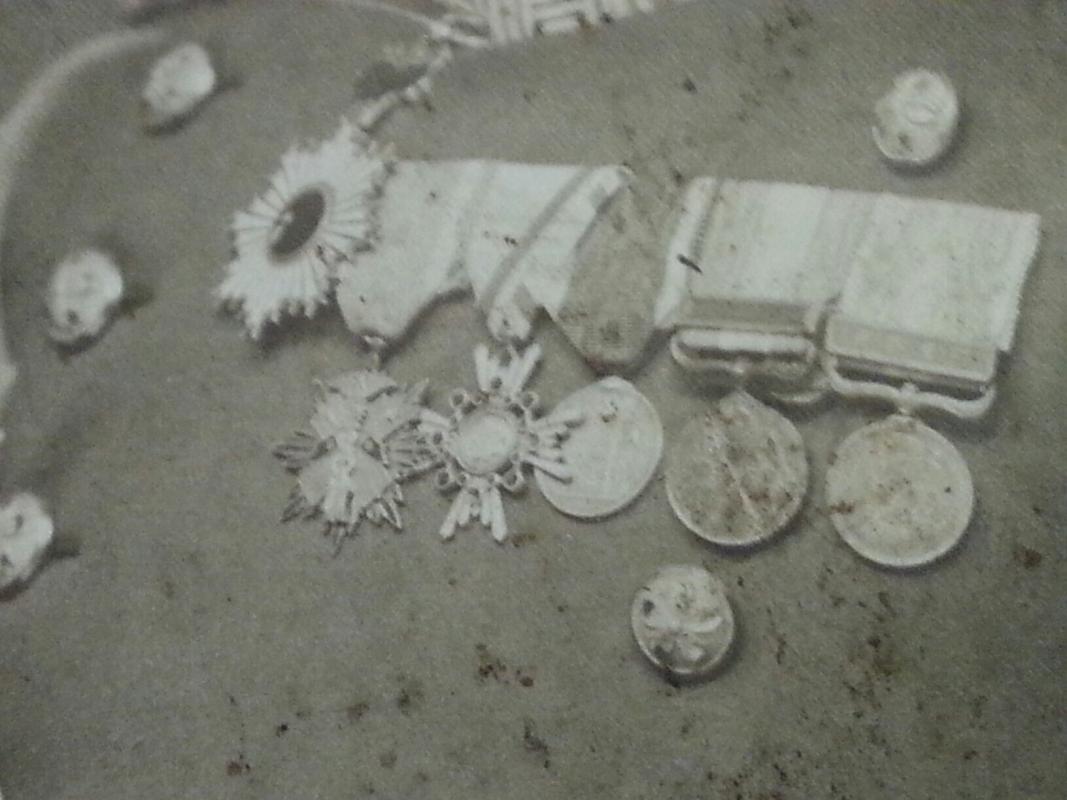 0
0 -
The same article, (on line) via the SMH web links ((society of Military History/VMI). Also, some other secondary sources, including tne almanach d' Gotha and the books mentioned above. The story gets more interesting as the recipient also has an interesting career.
Hotta does a good preliminary job of discussing the family/clan issues that created the careers of people like Tojo with the Boshin war.
Given the peacetime Japanese army was only 175,000 men (20,000 officers?) in 1903, records aren't overwhelming.
Id love to see your thesis! Is it in English? Did you also notice the losing clans sending sons into the navy as careers? The army seems to have been controlled firmly by the anti-Tokegawan "rebel" clans/families well into the 1930s.
0 -
very cool.
A couple of photos pilfered off the web-mostly US AfricaCom. Malawai is a key ally of the US and a lot of its military do traing with the US military.
Note the UN medals.

 0
0 -
Perhaps this photo will come out better....
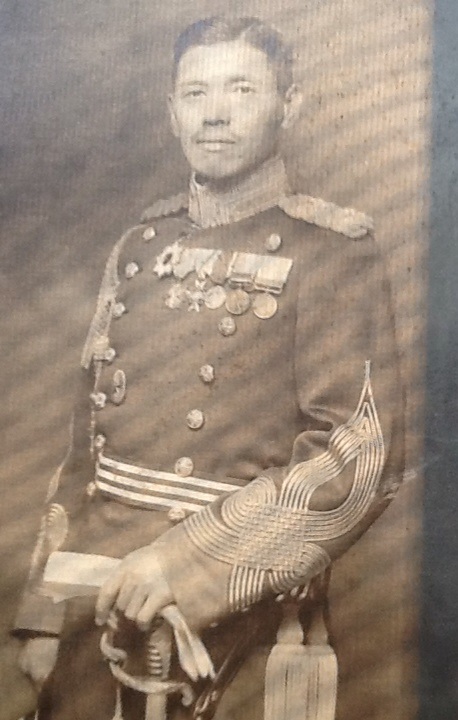 0
0 -
I got this photo off eBay this week from an antique dealer I know up the road. Sadly, I did NOT get the better companion photo of the Thai Prince with all the Saxon orders that went with it. I got it mostly because Im finishing the translated Russo-Japanese war trilogy(8 volumes total but starting in 1850) by Ryataru, or trying to anyway.
The NHk t.v. series by the way, is great.
The picture below is signed in beautiful, elegant script, " Herrn Hauptmann Scealte-zur freundlichen errinerung .Oberst O. Tamura den 29.9.1912".
A quick snout round my library and google brought together a surprising tale.
Tamura Okinosuke was born @1855, before the Black ships arrived and the US forced Japan to open her doors to unfair commercial trade and-for the Europeans, potential colonization. He grew up during the Bakematsu-the bloody, dramatic civil war era when the feudal Tokegawa Shogunite slowly died under the restless, chaotic forces of modernization, clan rivalries and untra-nationalism masked as Emperor worship. His older brother became one of the first members of Japans' new army and earned the ultra rare Formosia medal. As a cadet, young Tamura also took part in the truly epochal battles of Aizu, during the horrific climax of the Boshin War. Aizu would become an obscure fulcrum point in Japanese history. Most people remember it as the "last samurai war". While it was this, the clans involved later solidified into political/social factions that had ENORMOUS historical consequences several generations later. As Hotta points out in her brilliant book, the burning of Aizu castle led directly, step by step, to the sacking of Nanjing, Pearl Harbor and the mushroom cloud above Nagasaki.
In this photo, Colonel Tamura is freshly back from observing maneuvers and soon to depart Berlin, where he served as an attache from 1910-1913, to return to Japan. Earlier (1902-1905) he had served a year in a Magdeburg field artillery regiment and as an attache'. He was recognized as Japans' technical expert and knew the Krupp family well. Tamura knew Churchill (met during British army maneuvers in 1911) and a great many of the German general Staff. He corresponded with Bruckmueller. Back home in late 1913, he joined the Imperial General Staff and rose to LT. General in 1915, taking over the management of Buro 4, which was responsible for maps, histories and record keeping. He died in April 1919, just as Japan entered the height of its imperial phase.
Tamura was born and grew up in a time that was for all intents and purposes, the 12th Century. He studied to be a samurai and took part in the last Samurai battles. He watched his country modernize and , although he did not know it at the time, knew all the men who would later instigate World War Two and the atomic age. As an attache' in Berlin he met and took part in a glittering social and intellectual scene that one can only marvel at.
The man he sent the picture to also had an interesting career, which I shall write about later.
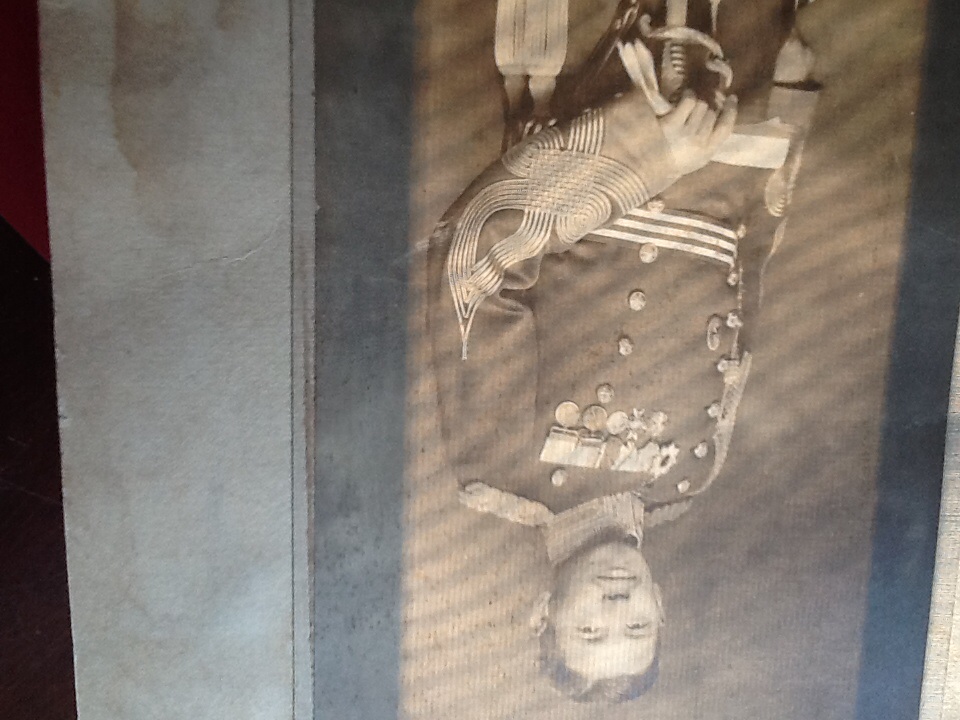
 0
0 -
Keep in mind that the entire field of ROKorean collecting is almost unknown, despite the ROKs' economic power. Most Americans have no idea how truly efficient the ROK troops were in Vietnam and also later ROK efforts via the UN and as US allies. The language barrier and lack of references in English is huge. So, the more obscure the more likely a piece is to be either real or a junk shop made up piece. I myself just discovered Im due an ROK medal! My second foreign award.
0 -
I have some hope, but also doubts. It could be a junk shop put together piece easily and barely worth the sum of its parts, but the medal and insignia story are so unusual, they almost make sense. In the early days of the ROK higher awards were given out more freely than later. One of the cardinal rules for medal awards is-the closer you ate to a General, esp. a Staff General, the more likely you are to get a gong. How to make sense of the WW2 US ribbons on an ROK jacket? Such things did happen, but rarely and hint at English proficiency. Korea at the time was a an unhappy province of Japan and poorer than Ethiopia (and would remain that poor until the mid 1960s).. However a lot of Koreans got out of Korea via the navy/ merchant marines. By "many" I mean a few thousand or more at best. Itd be interesting to see if this name popped up in a GHQ staff list some where.
0 -
yeah. that group is outstanding! Is there an article on him?
0 -
what a fantastic Ehrenkreuz site! The photos are fantastic.
0 -
Very cool. Can I post this on Facebook? Ed Haynes would know more.
0 -
Aren't these academic cords? Worn by scholars who passed or were taking the old civil service exams?
0 -
Yup. I agree, BUT...given the scarcity of Koreans who spoke english well before 1946, if this guy had the language skills, it (the WO/NCO) would make sense. I assumed a staff interpreter raised in a Mission school orphenage and maybe in the USN. Lots of navy cooks and other 'support' personnel were Asian (esp. Phillipeno).
The worst year medal was awarded liberally and we know it was given to lots of local politicians and others in prominent positions.
0 -
Theres a guy out there in cyber land trying to write a book on ROK awards. Is that perchance you? I know they changed several times, esp. in the early chaotic times. Id love to know more, esp. about Police medals.
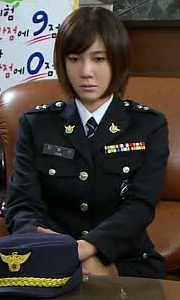 0
0 -
I think 7 is Hungarian WW1 and 8. is Austrian WW1 or red cross medal. I By the way-belated happy birthday Daniel.
0




Bavarian Leib Regiment evolution....
in Germany: Imperial Uniforms, Headwear, Insignia & Personal Equipment
Posted
Ah! right you are!